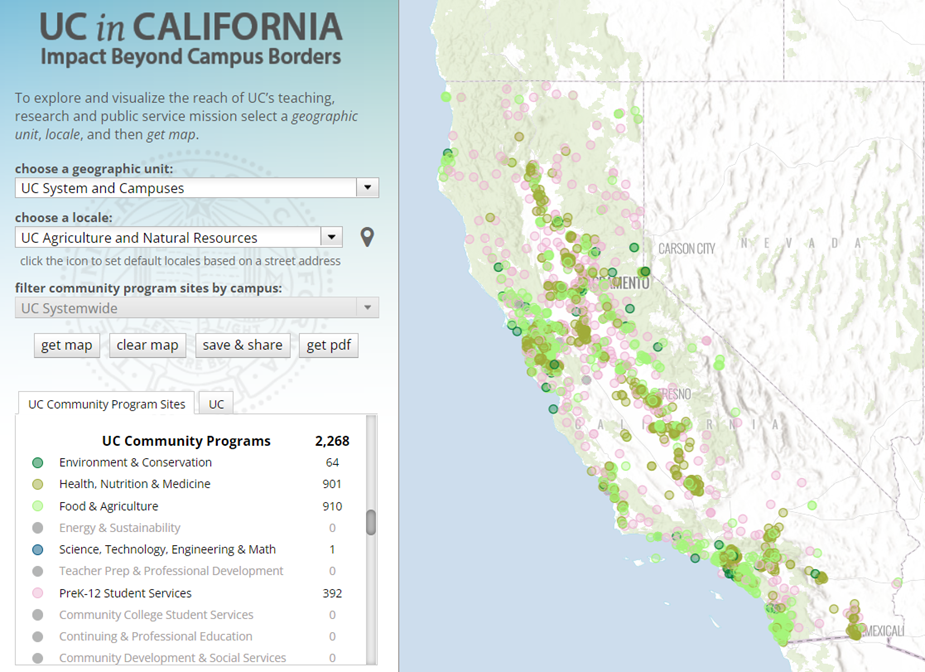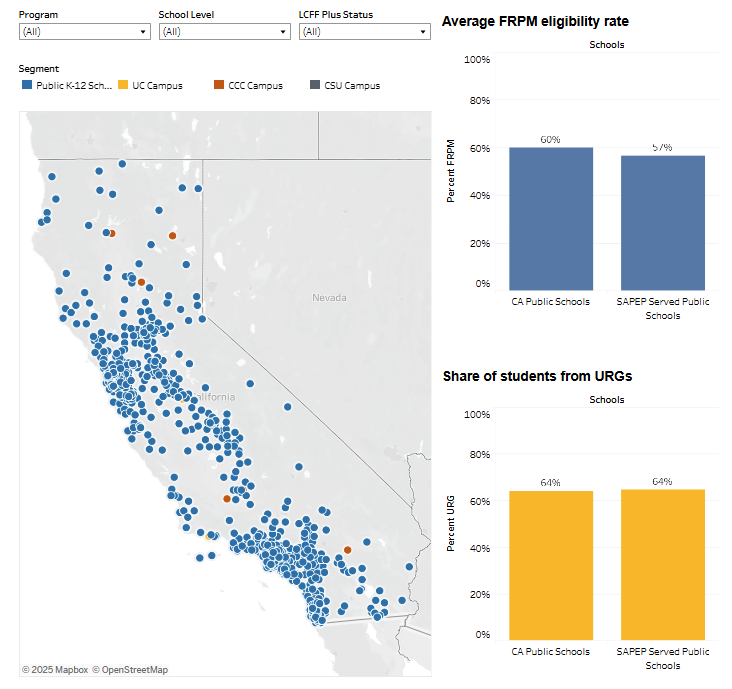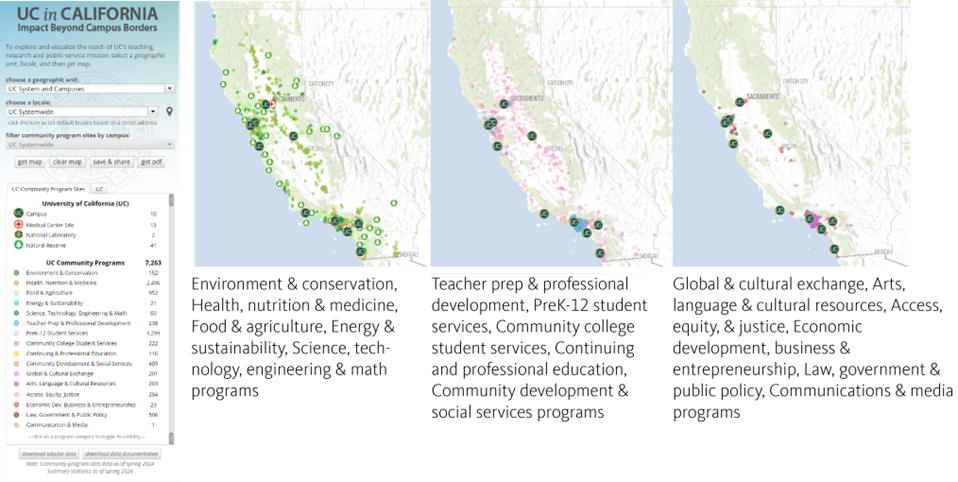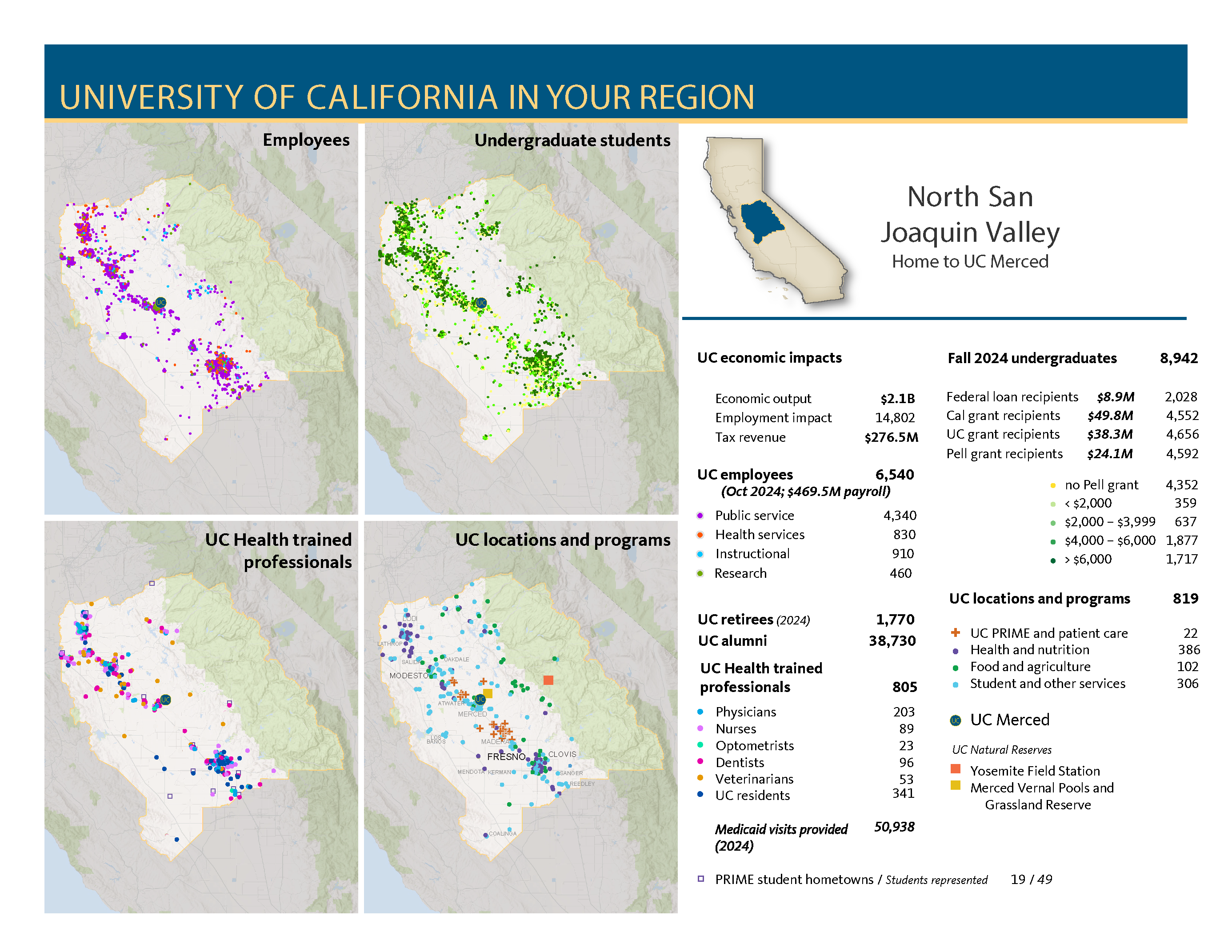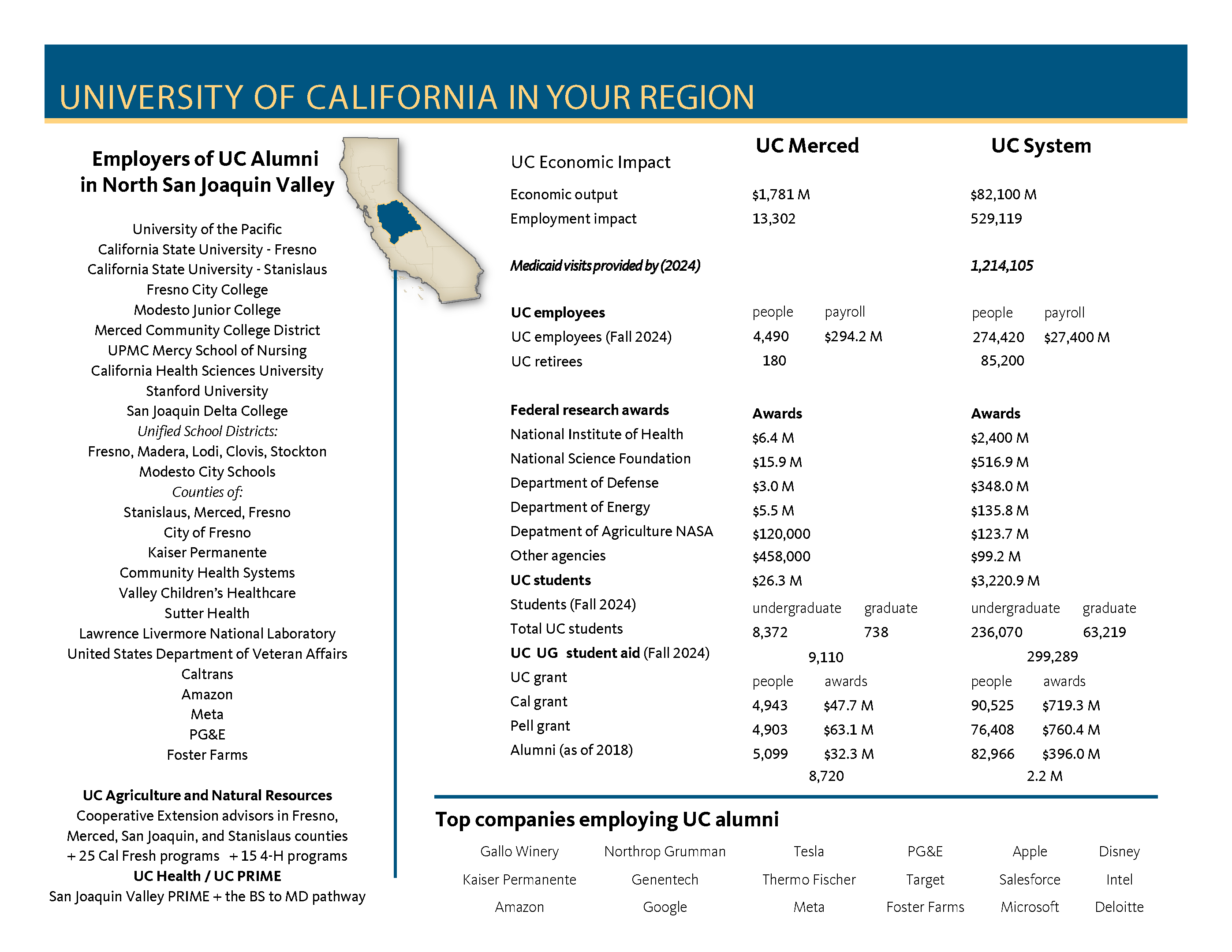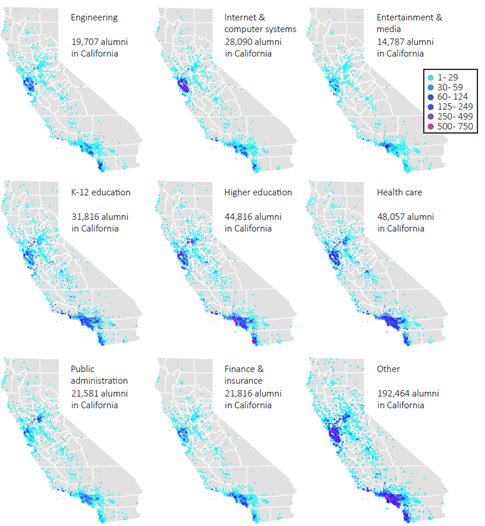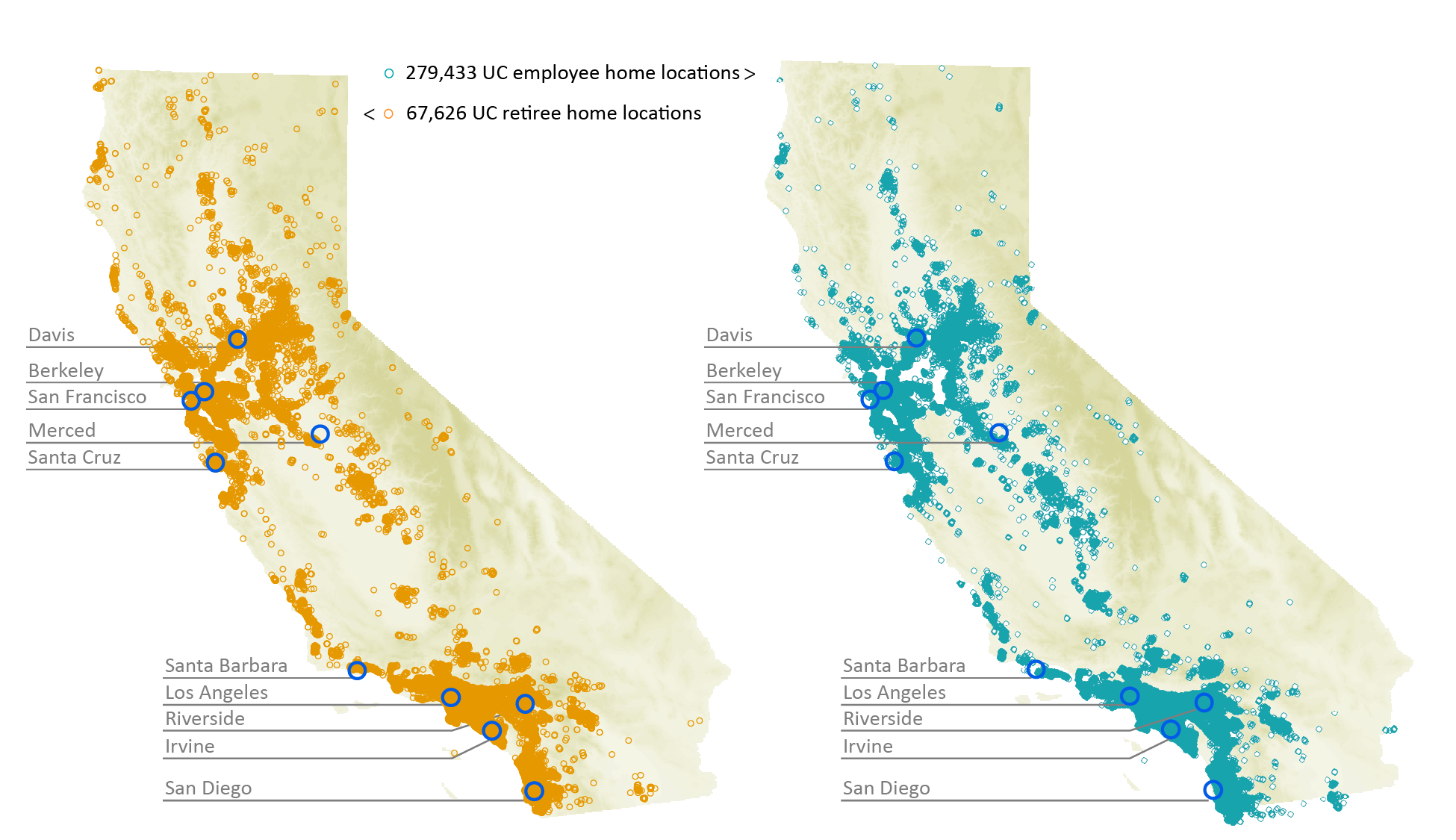Part of the UC mission
Along with teaching and research, UC contributes to the well-being of the state’s population and economic growth through its public service efforts. UC’s impact goes well beyond its on-campus activities. UC has a significant presence in nearly every community throughout California.
For example, UC Agriculture and Natural Resources (UC ANR) supports sustainable agriculture, environmental stewardship, healthy families, and education. Every UC campus and UCOP’s Division of Graduate, Undergraduate and Equity Affairs (GUEA) administer hundreds of community-based programs at thousands of sites in California across a range of foci, from community and social services to teacher professional development and K–12 student services.
UC Agriculture and Natural Resources
UC Agriculture and Natural Resources (UC ANR) implements the land-grant mission for the University, which emphasizes the development and dissemination of practical information to address critical agricultural, environmental, and societal issues. The land-grant system represents a three-way partnership with federal, state and county governments. More information about UC’s land-grant arm.
UC ANR statewide network and impact
UC ANR operates a statewide network of researchers and educators which includes the multi-campus Agricultural Experiment Station and statewide Cooperative Extension. There are approximately 510 Agricultural Experiment Station researchers located on five campuses: UC Berkeley, UC Davis, UC Merced, UC Riverside, and UC Santa Cruz. There are over 110 Cooperative Extension Specialists on nine UC campuses, Research and Extension Centers (RECs), and county offices, and 180 Cooperative Extension Advisors conducting research, outreach, and education in all 58 California counties. In addition, there are 13 statewide programs and institutes. UC ANR is often the face of the University to Californians with no other connection to UC.
UC ANR’s mission is to cultivate thriving communities, sustainable agriculture, resilient ecosystems, and economic prosperity in California through the development and sharing of equitable and collaborative science-based solutions that have national and global impact. Recently, extensive community input helped UC ANR identify seven distinct California challenges as priority areas in which UC ANR can make a significant impact. The core areas are Agriculture and Food Systems, Natural Ecosystems and Working Landscapes, and Thriving People and Communities. The new Strategic Vision 2040 also lists four issues that overarch all the research and extension work: Climate Change; Innovation; Regulations, Policy and Compliance; and Systemic Inequities.
Over the past year, the UC ANR network developed twelve novel ideas that led to patents and over 2,138 science-based, audience-driven education materials. UCCE academics and statewide programs had over 730,000 significant education exchanges, conducted over 33,800 meetings, workshops, field days, and courses, and engaged in over 1,830 science-to-policy activities. Over 18,400 volunteers donated over 1.35 million hours of service, with a combined effort that is valued at $52.2 million. These activities resulted in many measured outcomes. Several examples follow to illustrate UC ANR’s impact cultivating thriving people, protecting the planet, and growing prosperity. For more information on its breadth of impact see the 2024 UC ANR Annual Report.
People - Securing healthy, free school meals
The Nutrition Policy Institute (NPI) researches nutrition and food security policies, translating its findings to help lawmakers make informed decisions. NPI studied the impacts of California’s Universal School Meals Program, which offers breakfast and lunch daily to all public-school students at no charge, regardless of family income level. NPI found that the program is overwhelmingly supported by parents across all income levels, that participation has gone up, and that the program has multiple benefits, including improved food security for families and reduction of stigma around use of school meals. NPI academics shared these findings with state legislators who passed California Assembly Bill 107, securing ongoing funding for the program and ensuring students will continue to have access to healthy meals, including for the 44 percent of food-insecure families in California who do not qualify for free or reduced-price meals.
Planet – Building resilience to wildfire across California
The UC ANR Fire Network delivers fire-related research and outreach statewide that is adapted to local conditions and community needs. A couple ways that they support making California more resilient to wildfire are through prescribed fire, such as through Prescribed Burn Associations (PBAs), and targeted grazing. In 2024, UC ANR-led efforts that successfully applied beneficial fire to over 650 acres. Additionally, collaborative research on targeted grazing and using virtual fencing will provide land managers and grazers with best practices to further support wildfire mitigation efforts across the state.
Prosperity - Growing food and farm businesses
UC ANR leads the Southwest Regional Food Business Center, one of 12 USDA Regional Food Business Centers across the country. The center provides coordination, technical assistance, and capacity building for food and farm businesses across California, Arizona, Nevada, and Utah. The center helps producers gain access to local and regional supply chains, connecting them to wholesalers and distributors. Across the four states, over 300 food and farm business professionals increased their knowledge about new market opportunities and 145 reported increased revenue. In addition, 63 new food and farm businesses have been created through the center’s activities. In this way, the center fosters resilient, diverse, and competitive local and regional food systems.
Graduate, Undergraduate and Equity Affairs programs
Graduate, Undergraduate and Equity Affairs (GUEA) provides leadership and support for efforts that advance UC equity and inclusion, that promote access to and successful completion of baccalaureate and graduate degrees, and that help to provide an exemplary student academic experience. GUEA’s Outreach and Educational Partnerships supports and helps UC sustain partnerships with K–20 public education segments, community-based organizations, and the business sector. These collaborations advance college preparation, access, and degree-completion for students from underserved backgrounds.
Educational partnerships
The University of California’s Student Academic Preparation and Educational Partnerships (SAPEP) programs help prepare California students for higher education (10.2.1). SAPEP programs served 249,382 K–12 students at 1,811 public schools, and 29,969 community college students at 115 community colleges in 2023–24, the most recent year available.
The goal is to promote achievement by supporting academic preparation and college readiness. Programs include the Early Academic Outreach Program (EAOP), which focuses on “a–g” course completion (a prerequisite for admission to UC and CSU); K–20 Regional Intersegmental Alliances (aka P–20), creating ties between campuses, schools, local communities, and business organizations; The Puente Project, focusing on college-preparatory English skill development; Transfer Prep, focusing on community college transfer support; and Mathematics, Engineering, Science Achievement (MESA), focusing on STEM (science, technology, engineering, and mathematics) skills development. The Mathematics, Engineering, Science Achievement (MESA) program integrates UC’s core missions of teaching and public service by focusing on the academic preparation of students at K–12 schools, community colleges, and four-year universities. Through its three components — the MESA College Prep Program (formerly known as MESA Schools Program or MSP), the MESA Community College Program (MCCP), and the MESA University Program (formerly known as MESA Engineering Program or MEP) — MESA served 26,769 California students in the 2023-24 academic year.
MESA College Prep centers are housed in 18 locations and serve more than 12,800 students at 371 K–12 schools. Centers offer classes that reinforce math and science content standards. MESA activities include workshops aimed at strengthening study skills, monitoring progress, and encouraging students to pursue degrees in STEM.
The MESA Community College Program (MCCP) manages 94 centers at community colleges, serving close to 7,000 students annually. These centers provide academic excellence workshops, orientation courses, academic advising, and counseling activities to help community college students transfer to a four-year university in a timely manner.
The MESA University Program operates 17 centers located in public (UC and CSU) and private universities across the state. Serving more than 7,000 students annually, these centers assist college students in attaining four-year degrees in engineering and computer science by providing tutoring and academic skills workshops. In partnership with local industry leaders, MESA University Program centers also provide career and professional development opportunities for students.
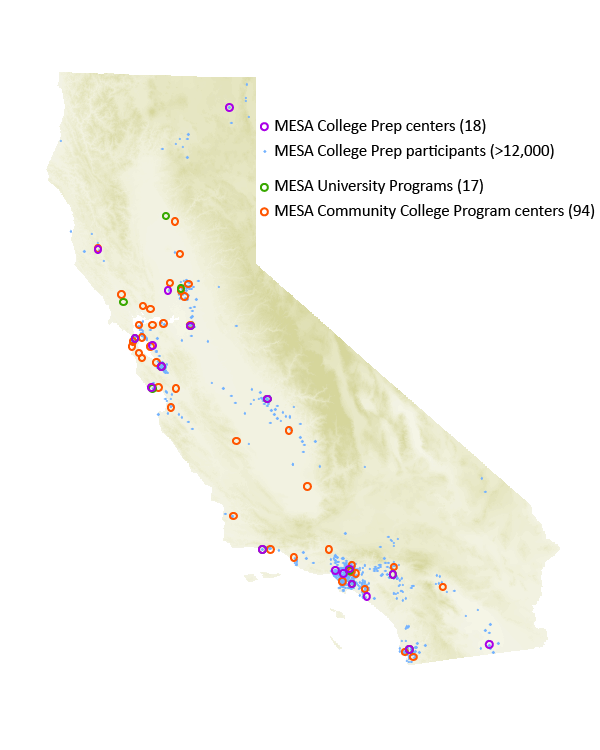
UC also plays an important role in preparing California’s teacher workforce. UC’s Teacher Education Programs prepare teacher candidates to engage students in rigorous, relevant, and inquiry-based educational experiences. Located at eight UC campuses, Teacher Education Programs recruit, prepare, and support educators who are committed to academic excellence, equity, and integrity, and to cultivating the highest levels of achievement and opportunity for all students.
UC also provides ongoing support to educators already in the workforce through professional development programs. For example, the California Subject Matter Project (CSMP) is a network of nine discipline-based statewide projects, providing more than 700 professional development events for educators at more than 2,500 schools each year. CSMP professional learning opportunities are aligned with state-adopted standards and are collaboratively designed by K–12 and university educators to enhance learning for all students (10.2.1).
Social and economic impact
Including the programs of ANR and UC’s educational partnerships mentioned above, the University of California administers community-based programs at more than 7,000 sites across the state. The data on these sites is still being submitted into a new database and the number is expected to exceed 10,000. UC in California; Impact beyond campus borders, displays these programs on an interactive website. Because the well-being of every California citizen and community is important, all campuses sponsor and manage programs far from their campus locations (10.3.1).
Critical to the success of the University is a shared understanding with the California Legislature and California public of the enormous benefit UC provides to the state; its social and economic impact can be demonstrated with the UC impact in California regions maps (10.3.2).
More than 1.2 million UC alumni are known to live and work in California (10.3.3). They are leaders, volunteers, and contributors to the vitality of the state’s communities, businesses, and culture. UC’s operations also add significantly to the state’s economy. With more than 279,000 employees, UC is California’s second-largest employer (10.3.4). True to its land-grant mission, the UC system touches many aspects of life in California. The UC public service mission has evolved in tandem with the changing needs of our state and local communities, and has developed programs and partnerships that improve the lives of all Californians.
![]()

